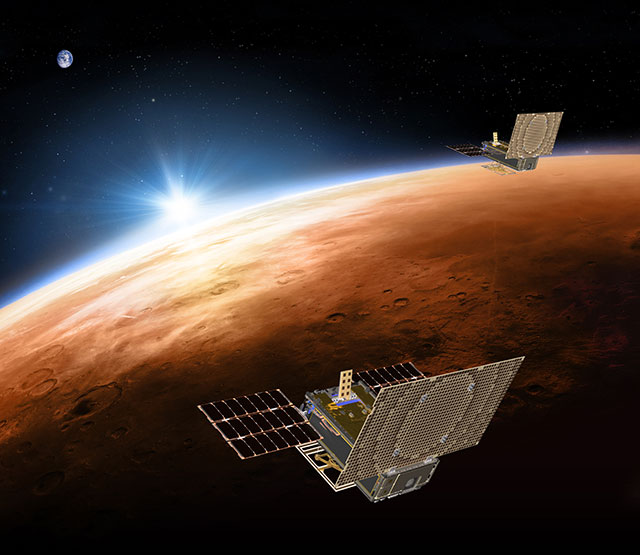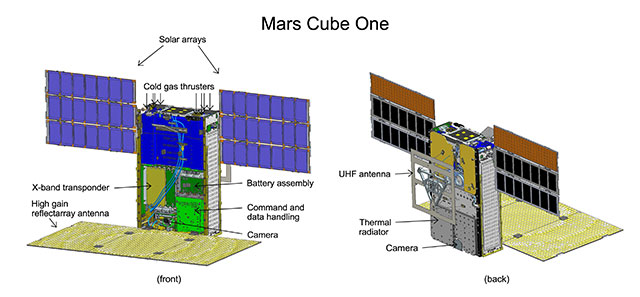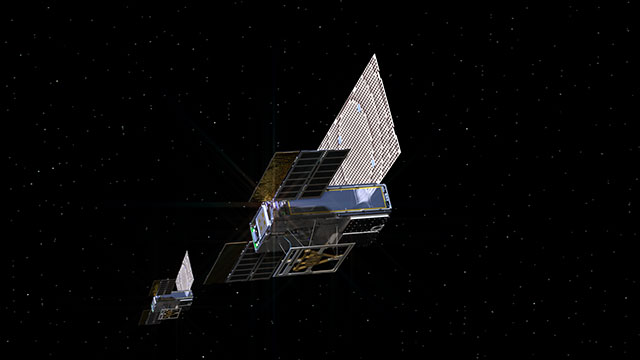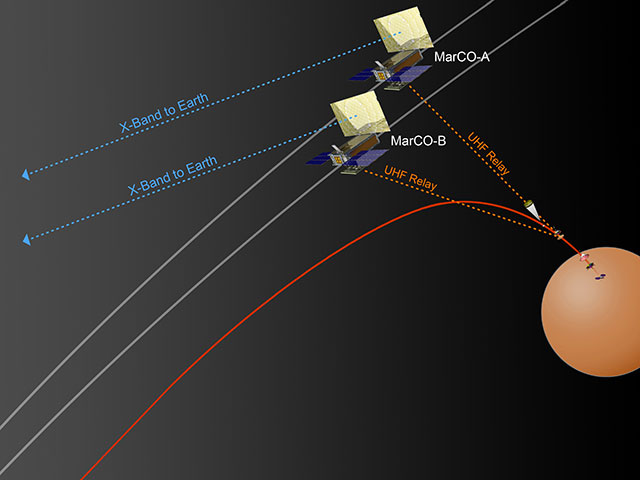Technology Demonstration
A technology demonstration called Mars Cube One (MarCO) will be the first deep space use of miniature, modular "CubeSat" spacecraft design. The pair of briefcase-size spacecraft -- MarCO-A and B -- will launch on the same rocket as InSight and carry out a number of risky communication and navigation flight experiments. If successful, the twins, MarCO-A and MarCO-B, will fly separately towards Mars and potentially pass the planet at about 2,175 miles (3,500 kilometers) away just as InSight is landing. One could potentially receive transmissions from InSight and relay status information to Earth about the lander's descent and touchdown.
All previous CubeSats have orbited the Earth. MarCO is the first attempt to go to another planet. By verifying that the technologies for interplanetary missions are feasible and can be developed on a short timeline, this test mission could lead to many other SmallSat applications for exploring our solar system. Some could provide similar support functions as "carry your own" relay providers. Others could have primary scientific research functions of their own, such as radio transmissions through planetary atmospheres, imaging with small cameras, observations with other miniaturized instruments, or in-place measurements of space environments.
The success of the InSight mission does not depend on MarCO's performance. NASA's Mars Reconnaissance Orbiter (MRO) and large radio telescopes on Earth are also expected to receive transmissions from InSight during descent and landing. MRO will hold that data for more than an hour while circling Mars before transmitting it to Earth. The radio telescopes will only be able to listen for “aliveness.” However, should a MarCO CubeSat make it all the way to Mars, each has the capability to relay a substantive amount of data almost immediately, transmitting status information on an 8.7-minute, speed-of-light trip to Earth across about 97.5 million miles (157 million kilometers) between the two planets.

JPL engineer Joel Steinkraus works with one of the MarCO CubeSats during an outdoor test of its solar arrays.
The reason for flying two identical MarCO spacecraft is redundancy in case either one does not operate as planned.

CubeSats are a class of spacecraft based on a standardized small size and modular use of off-the-shelf technologies. Many have been made by university students, and hundreds have been launched into Earth orbit using extra payload mass available on launches of larger spacecraft.
The basic CubeSat unit is a box roughly 4 inches (10 centimeters) square. Larger CubeSats are multiples of that unit. MarCO's design is a six-unit CubeSat. Each of the two spacecraft has a stowed size of about 14.4 inches (36.6 centimeters) by 9.5 inches (24.3 centimeters) by 4.6 inches (11.8 centimeters).
The spring-loaded CubeSat deployment system for MarCO is on the aft bulkhead carrier of the Centaur upper stage of InSight's Atlas V launch vehicle. That is near the base of the Centaur, not inside the fairing that encloses the main spacecraft. At launch and until the Centaur upper stage separates from the first stage of the Atlas V, the aft bulkhead carrier is sheltered within an inter-stage adaptor between the launch vehicle and the second, or upper, stages.
After the Centaur upper stage has released the InSight spacecraft on course toward Mars, it will do a short roll, then release MarCO-A, roll 180 degrees further and release MarCO-B.




